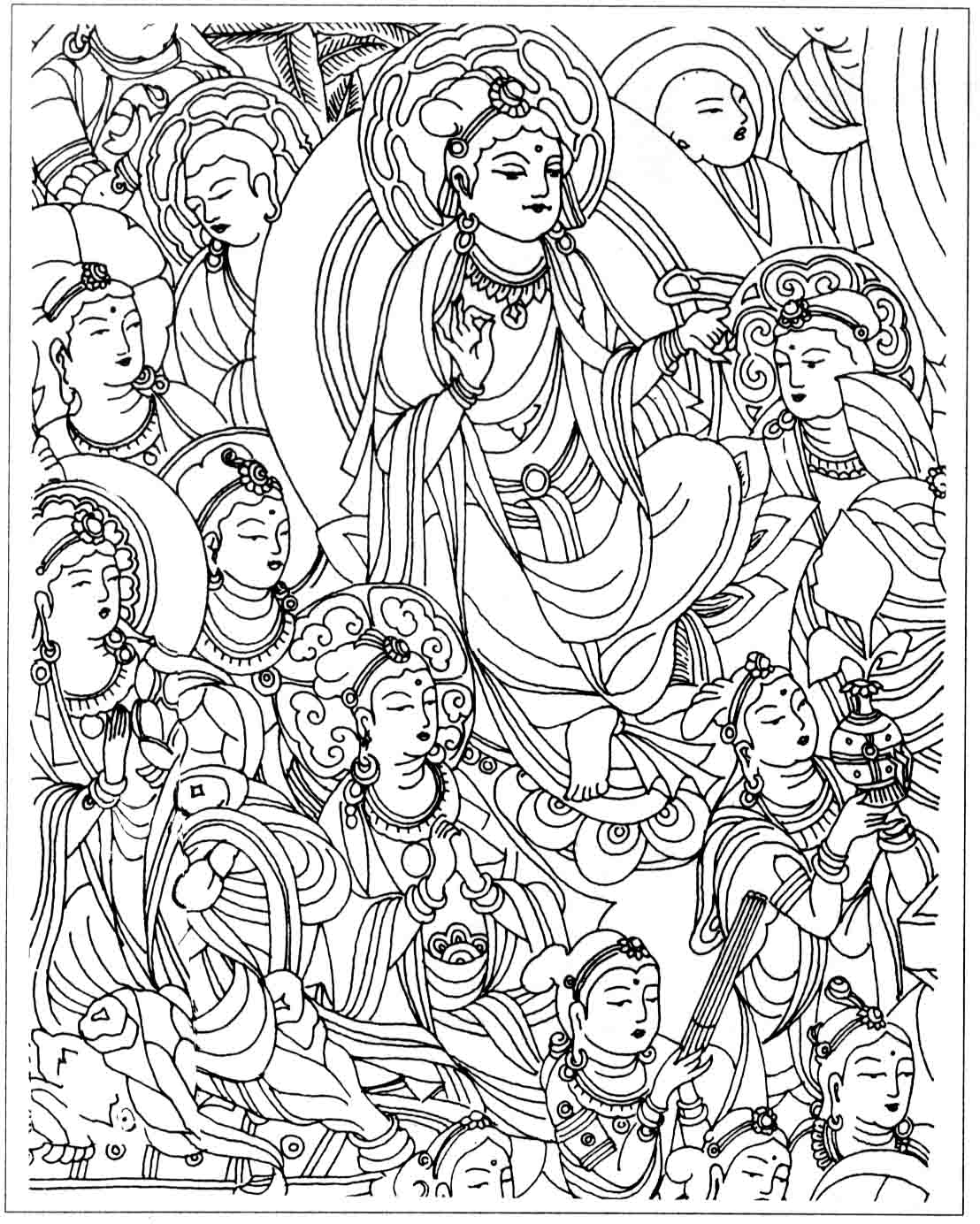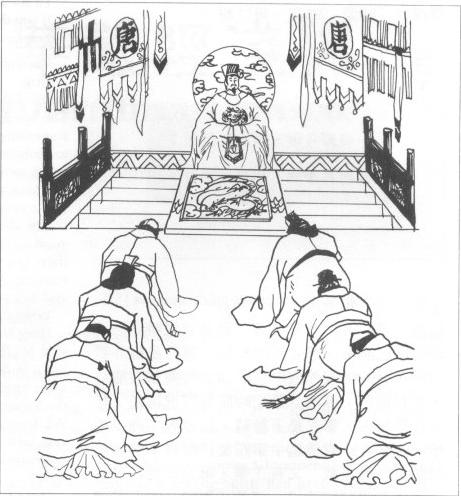
恆觀:我們所說的道理,我可以講一講嗎?
上人:講什麼呢?那你再講一講你的見解。
恆觀:爾時,可以有三個講法。第一句「爾」字就是昨天晚上師父講的,是你聽的時候,你聽的時候就是爾時。
現在介紹爾時的第二個意思,那個是什麼時候呢?就是在《華嚴經》前邊介紹這個主空神的名字時,後來我們看這經上寫主空神所悟到什麼解脫門、明白什麼解脫門,而所有的主空神在得到這個解脫門了,就讚歎佛幫助他們得到,所以這個「爾時」,也就是那個時候。為什麼講這個「爾時」?就是因為如果沒有講這個「爾時」,就會令聽經的人害怕,沒有法子明白這個意思。所以在講這一段經文時,就說「爾時」,這時候就是要讚歎佛來講這個偈頌。可是這個「爾時」是根本沒有什麼時候,所以第三個意思,這個「爾時」就是如是;什麼是如是?什麼不是如是?如就是如如的意思,這個「如」是什麼都是如如、如是,所以這個時候就是沒有一個時候。
這段經文就是講淨光普照主空神,這個神就是個主空神。在這個時候講這爾時是沒有一個時候,因為在空中就沒有什麼,怎麼會有一個時候?怎麼會有時間?可是在空中什麼都有,所以也可以講有這個「爾時」。總而言之「爾時」是什麼?就是看人的境界,究竟爾時就是爾時。
上人:下一位是誰?果逸?
恆隱:我就講師父的偈頌,就是講一個四句偈頌,但是裡邊要改一個字,本來有個「是」,要改成「時間」的時,可以說:
一切時考驗,看爾怎麼辦?
睹面若不識,須再從頭練。
上人:下一位是誰?
恆持:還有五個意思,第一就是欲說時--正說時,已說時,想要說的時候。第二是破外道,因為有的時候外道所說的關於時間都很籠統,也有偏見。佛法就是把時間解釋很清楚,也不會欺騙人。第三是下種時,這是說,種下善根,未來可以成佛道。第四是正師時:有真正的師父,有正教,又有正學。第五是佛願意說,眾生願意聽的時候。這是「爾時」的五種講法。
上人:果普,講!
恆賢:我不一定知道,可是我想這個「爾時」是阿難尊者說的。在我們的世界裡邊,是釋迦牟尼佛用法身來說《華嚴經》。可是我們有這部經典是阿難尊者說他聽佛講的。我們現在聽《華嚴經》已經有一年……。
上人:不只一年了吧?兩年了吧!
恆賢:這個懸談也用一年講的。(編按:開講華嚴經之前,於一九七一年六月十三日先在三藩市金山寺講華嚴經疏序。)佛在經典裡邊還沒有說話。可是有很多眾生「承佛威力」說話。這兩個字「爾時」,我想是阿難在結集經典的時候說的。
上人:…用一個大刀闊斧,那兒有刀,給他們評判一下。
妙境法師:要我講?
上人:嗯,請你給他們批評。這個妙境法師說你們大家都不誠心,他就不想要批評,你們大家得怎麼樣才表示你們的誠心呢?
妙境法師:不須要。
上人:那就給他們批評批評,我們大家都是在門裡邊,沒有在門外邊。關上門我們誰都可以做皇帝。〔眾笑〕
妙境法師:《華嚴經》第一卷,第八頁後半云:「如是我聞,一時佛在摩竭提國,阿蘭若法菩提場中,始成正覺。」這裡這個「時」是佛成道的時候。底下下邊,「爾時妙嚴海天王,承佛威力,普為一切自在天眾而說頌言。」以下這個爾時呢,是聽佛說法的這個天王,或者是夜叉神、主空神、主方神、主風神,這些人在說偈頌的時候,可以這樣分類。佛成道以後,這麼多的菩薩、天龍八部來集會。看這個文的次第,最初說偈頌的是天王,以下還有一些天王,那麼還有一些神。看這個文的意思就是這些王、神,過去都是佛的弟子,親近過佛的,現在這個悉達太子他成佛了,那麼他過去的弟子修行也都是得解脫了。各得各樣的解脫門,就一方面讚佛,一方面也是向佛報告:「你修行成佛了,我們雖然沒有得究竟無上菩提,但也是得解脫門了。」那麼按這個意思來講,前面是佛成道時,這底下呢,就是弟子讚歎佛,來向佛報告的時候,可以這樣大概的分類。
另一方面來說呢,佛成佛以後,那麼很多的菩薩、很多的天龍八部來集會,這都是一個因緣法,不是講的第一義諦。這個因緣法當然是有前後的,有次第的。這個第二卷頭一句話:「爾時如來道場眾海,悉已雲集。」這又是有個「時」,這個「悉已雲集」,大家都已經集會來了,要來的已經都來了。從這裡可以分開,就是有前後了。那麼成道是在前,大家集會來,這是在後;讚歎佛、向佛說偈頌,又是在後了。從圓融無礙這方面來說呢,是有次第,也是沒有次第,可是在這個世俗諦的立場,在沒有次第裡面,還是有次第,那麼就有前後的不同。可是大家說偈頌,我這麼推測,從別的文上,像鳩摩羅什法師有提過,就是這些菩薩也好,天王也好,神也好,見到佛的時候,他就讚歎,都說偈頌來讚佛的。那麼他什麼時候讚佛呢?當然是來到這個菩提場以後才會讚歎佛的。
可是有菩薩,有天龍八部,他們是不是按照次第來讚佛?是不是你讚歎完了,我才讚歎,或是我讚歎完了,你才讚歎?那麼從這一方面想,可能不是這樣子,是來了就讚歎。這文上沒有說菩薩讚佛,先說這個天王和天龍八部,可能是來了就讚佛的,就是他到了這個菩提場以後,一見到佛他就讚歎了,就向佛報告。那麼這樣講呢,這個爾時,這天王讚歎佛的時間,和這個主空神、主方神、主風神說偈頌的時間,可能是沒有前後。這是從世俗諦的立場來說。那麼結集經的人呢,他也很巧妙,他也沒有給他說誰先誰後,就是用「爾時」的這個字樣來記錄這件事情。爾時某某人,爾時某某神、某某天王他就「而白佛言」,說了偈頌,來頌揚他們修行的程度,得什麼解脫門了。那麼這都是從世俗諦的立場來分別這個前後。像剛才恆靜法師用這十種時間來講呢,那是究竟的一種境界。可是我們講《華嚴經》,大家在學習、在研究,要有次第和無次第都並重,要依文解義,也要依義來解文,這樣子我們由開始到最後可以漸漸地深入。
待續
|
|
Heng Kuan: Could I say something about the principles we’re discussing?
Venerable Master: What do you have to say? Speak about your outlook.
Heng Kuan: There are three possible interpretations of “at that time.” The first interpretation is that given by the Venerable Master yesterday evening (October 31, 1973), namely “at that time” being whatever time you are listening to this.
Now I will introduce the second interpretation. What time is that? It’s the time within the Flower Adornment Sutra when the names of the Emptiness-Ruling Spirit had been given, and the liberation doors which those Emptiness-Ruling Spirits had awakened to and understood had been described in the Sutra text. At that point, they were going to praise the Buddha for helping them have such attainments. That, then, is the reference of “at that time.” Why say “at that time"? It’s because if you didn’t say it was at that time, the people listening to the Sutra would become afraid and would have no way to understand that meaning. That’s why when that time arrives, then in the Sutra text it says, “at that time.” The time, then, is when the verses praising the Buddha are about to be spoken.
However, as to “at that time,” fundamentally there is no such time. Hence the third interpretation of “at that time” is at a time which is thus. What is thus? What is not thus? The meaning of “thus” indicates that everything is thusness, just as it is, and so there is no time.
This section of text is describing how, when the Emptiness-Ruling Spirit named Pure Light Shining Everywhere was speaking “at that time,” there was not a time. That’s because emptiness is the absence of anything, so how could there be a specific occasion or time? And yet everything exists within empty space, and so one can also say “at that time.” To sum things up, what is “at that time"? It just depends on the state of the individual. Ultimately, “at that time” is just that time.
Venerable Master: Who’s next? Kuo I?
Heng Yin: Because there is not any time, I’ll just say a four-line gatha by the Venerable Master, and change one word in it—that’s the word “thing” —to the word “time.” And it’s:
Every time is a test
To see what you will do.
If you don’t recognize what’s before your eyes,
You have to start anew.
Venerable Master: Who is next to speak?
Heng Ch’ih: There are also five interpretations of “at that time.” The first is the time when something was about to be said. The speaking was already going on, things had been said, and something was about to be said. The second is time which serves to dismiss outside ways, those of externalist persuasions, because sometimes those teachings do not deal with time in a true and accurate way. They are opinionated, but the Buddhadharma doesn’t cheat people. It deals very clearly with time. It explains it. The third is the time of planting seeds, which means planting good roots for future Buddhahood. The fourth is the time when there is a true and proper Teacher—proper teaching and proper learning. The fifth is the time when the Buddha wanted to speak and living beings wanted to listen. Those are the five.
Venerable Master: Gwo Pu, you talk.
Heng Hsien: I’m not really sure, but I think “at that time” was said by the Venerable Ananda. In our world-system, Shakyamuni Buddha used the Dharma body to speak the Flower Adornment Sutra. But the way we came to have the Sutra was because the Venerable Ananda told us he had heard it from the Buddha. We have been listening to the Flower Adornment Sutra for a year now... (fall of 1973)
Venerable Master: Not just one year, right? It’s been two years, right?
Heng Hsien: The Prologue was also lectured for a year.
(Historical note: The lectures on the Flower Adornment Sutra began with the Flower Adornment Preface on June 13, 1971, at Gold Mountain Monastery in San Francisco).
Up to now in the Sutra text itself, Shakyamuni Buddha has not yet spoken; but many other living beings have been receiving the Buddha’s awesome strength and speaking. However, I think the words “at that time” were spoken by the Venerable Ananda when the Sutras were being compiled.
Venerable Master: Dharma Master Miao Jing, use battle ax and broadsword to critique them.
Dharma Master Miao Jing: Do I need to talk?
Venerable Master: Please evaluate them. (to the group) Dharma Master Miao says since you are not sincere, he doesn’t want to critique you. What can you do to show your sincerity?
Dharma Master Miao Jing: That’s not necessary.
Venerable Master: Then you should critique them. We’re all insiders. No one is an outsider. Behind closed doors, any one of us can be an emperor. (laughter)
Dharma Master Miao Jing: Roll one of the Flower Adornment Sutra, in the second half of page 8 says, “Thus I have heard, at one time the Buddha was in the country of Magadha in the Bodhi Way Place of Aranya (Arana) Dharma, having just accomplished Proper Enlightenment.” The “time” in that case is when the Buddha had accomplished the Way. Later on the text says, “At that time, the King of Gods named Sea of Wondrous Adornments received the Buddha’s awesome might, and universally for the multitudes of Gods of Sovereignty, spoke the following verses.” “At that time” in these subsequent passages refers to when those listening to the Buddha speak Dharma—namely, the Kings of Gods, the Yaksha Spirits, the Emptiness-Ruling Spirits, the Direction-Ruling Spirits, the Wind-Ruling Spirits, and so forth—speak verses. It can be divided like that.

After the Buddha accomplished the Way, all those Bodhisattvas, Gods, Dragons and others of the Eightfold Division assembled. According to the order of occurrence in the text, the first verses were spoken by certain Kings of Gods, followed by other Kings of Gods, then various Spirits. The text seems to indicate that those Kings and Spirits had been the Buddha’s disciples in the past, and had drawn near the Buddha. Hence when Prince Siddhartha accomplished Buddhahood, his disciples from the past all cultivated and achieved liberation. Each had an individual attainment to a type of liberation door. On the one hand they then praised the Buddha. But they were also reporting to the Buddha saying, “You cultivated and became a Buddha, and even though none of us has achieved ultimate Unsurpassed Bodhi, we have attained doors to liberation.” According to that interpretation, then, the prior reference is to when the Buddha accomplished the Way, and the subsequent references are to when the disciples praised the Buddha and made their reports. Such an overall distinction can be made.
Viewed from another angle, when the Buddha accomplished Buddhahood, the assembling of all the many Bodhisattvas, Gods, Dragons and others of the Eightfold Division was just in terms of dharmas involving causes and conditions, and not truth in the primary sense. Of course, dharmas of causes and conditions have sequential order to them, some coming before and some after. The first line of roll two says, “At that time, when the sea-like multitudes had all assembled like clouds in the Way Place of the Tathagata.” This too is referring to a time, namely when they “had all assembled like clouds.” Everyone who was supposed to come had already arrived, and they were all gathered together. There is also a temporal sequence involved here: accomplishing the Way came first, and the multitudes gathering came afterwards. Their praises of the Buddha and the verses they spoke for the Buddha were all subsequent in time. From the vantage point of unobstructed interpenetration, the sequence is not a sequence. However, in terms of mundane truth, right within non-sequence there is still sequential order—differences of what comes before and what comes afterwards.
As to the verses which all of them spoke, it seems to me—and Dharma Master Kumarajiva made the same suggestion concerning another text—that whether they were Bodhisattvas, Kings of Gods, Spirits or whatever, when they saw the Buddha they praised him. They spoke verses in praise of the Buddha. What time was it when they praised the Buddha? Well, naturally it would have to be after they had arrived in the Bodhi Way Place that they praised the Buddha.
But did the Bodhisattvas, Gods, Dragons and others of the Eightfold Division praise the Buddha in order, one after another? Was it only when one had finished his or her praise that the next one spoke in praise? Did they have to wait for each other? From one point of view, perhaps it wasn’t that way. They may have spoken their praises as they arrived. The text doesn’t talk about the Bodhisattvas praising the Buddha, but begins with Kings of Gods, then Gods, Dragons and others of the Eightfold Division. It may well be that they praised the Buddha upon their arrival. That is, after they had come to the Bodhi Way Place, as soon as they saw the Buddha, they praised him and made their report to the Buddha. If we interpret “at that time” in that light, then quite possibly the time when the Kings of Gods praised the Buddha and the time when the Emptiness-Ruling Spirits, the Direction-Ruling Spirits, the Wind-Ruling Spirits and so forth spoke their verses did not involve consecutive order. That’s speaking from the point of view of mundane truth.
As to the people who compiled the Sutras, they were also very clever. They didn’t say who was first or last. They used phrases like “at that time” to record the events, saying, “at that time” such and such a person, “at that time” such and such a Spirit or King of Gods spoke verses, and the verses served to describe the levels they had reached in their cultivation, the doors to liberation which they had attained. All of those determinations of “before” and “afterwards” are in terms of mundane truth. But the interpretation using the ten times given just now by Dharma Master Heng Ching is a kind of ultimate state. However, during this Flower Adornment Sutra lecture series, everyone is in a period of study and investigation, and so there needs to be emphasis on both the sequential and the non-sequential aspects. We need to use the text to understand the meaning, and use the meaning to understand the text. In that way, as we go from beginning to end, we can enter more and more profoundly.
To be continued |